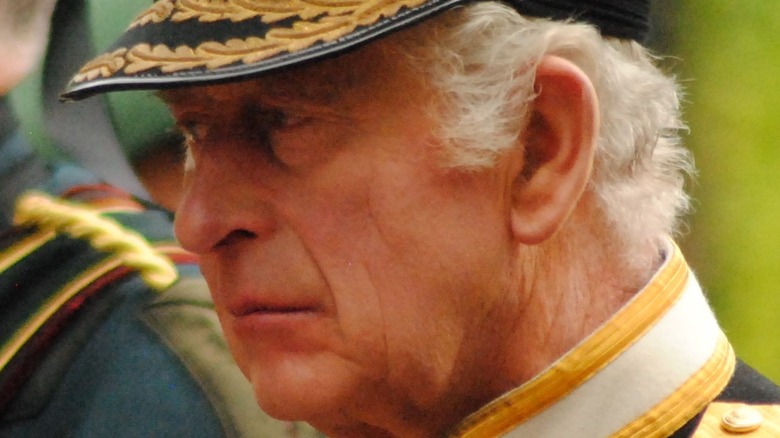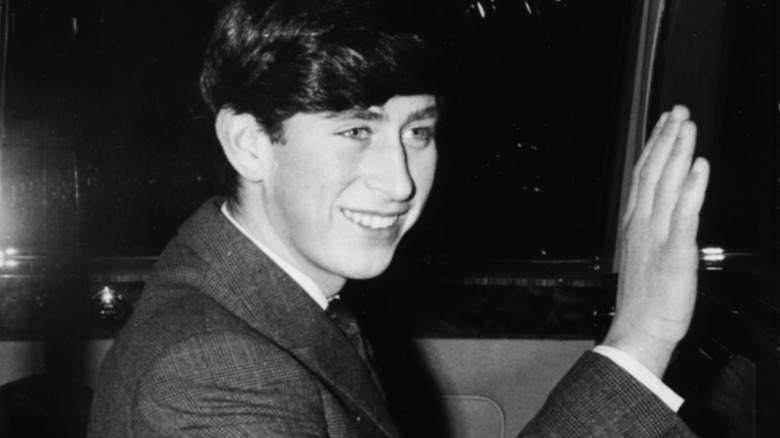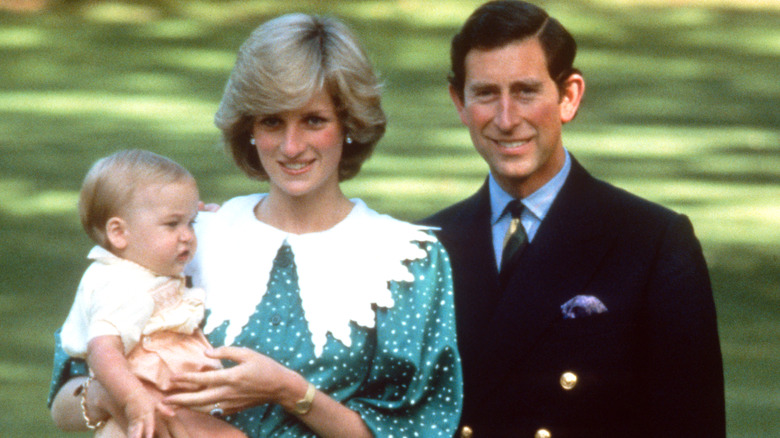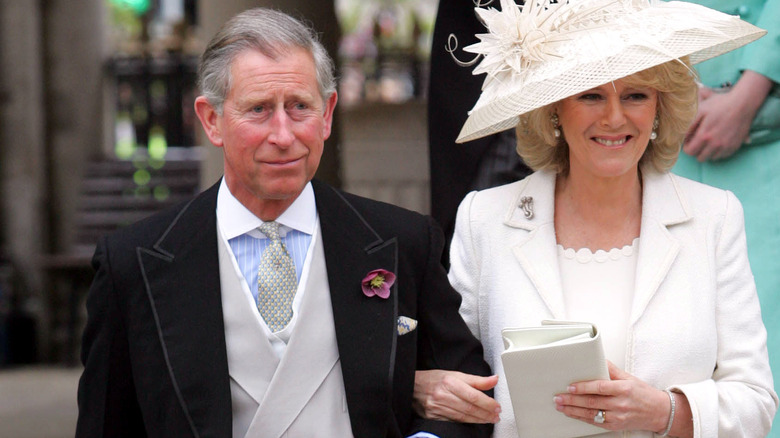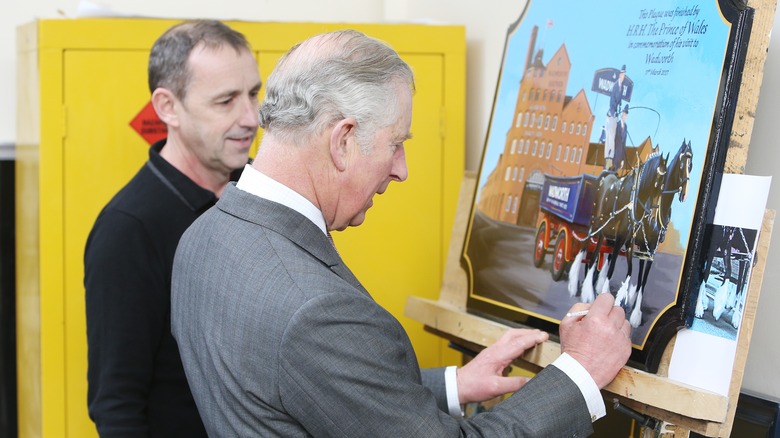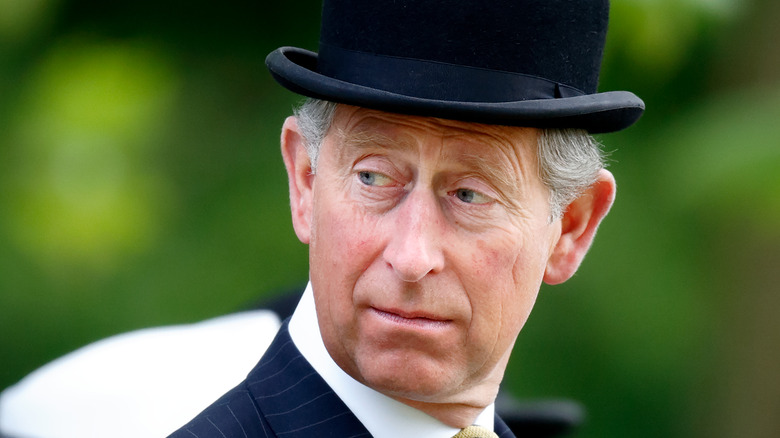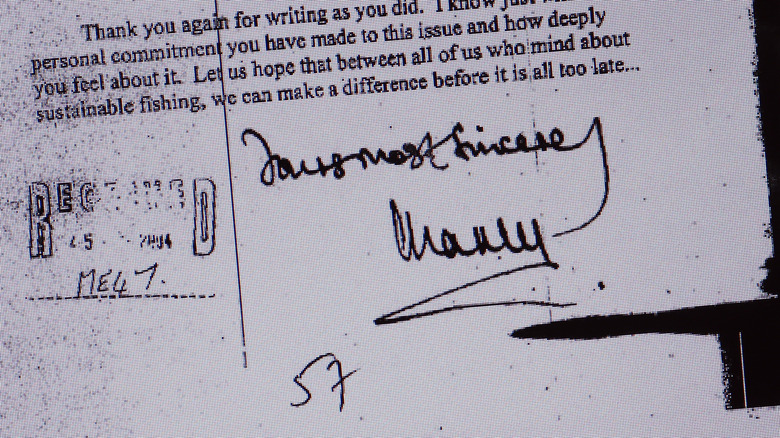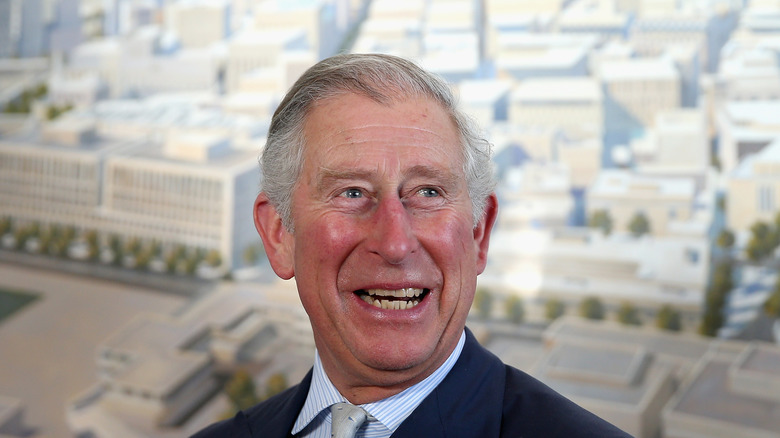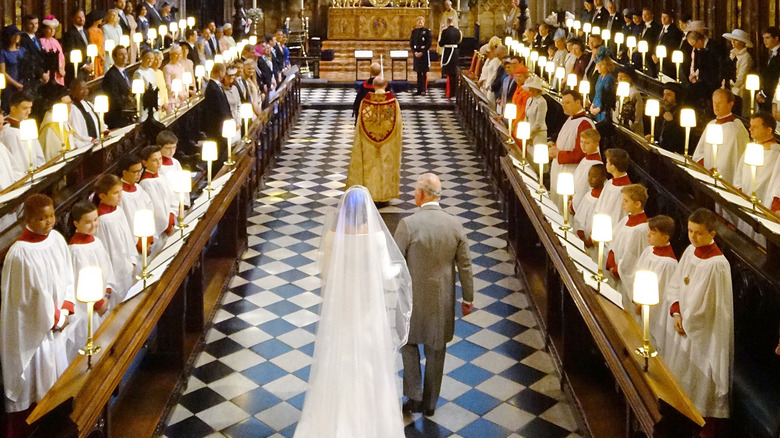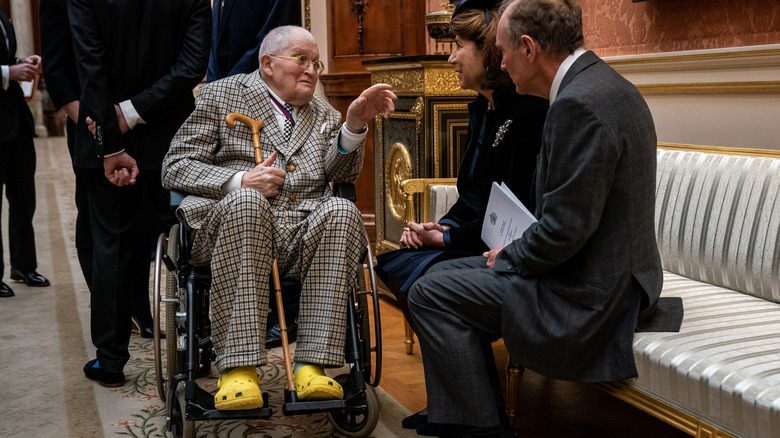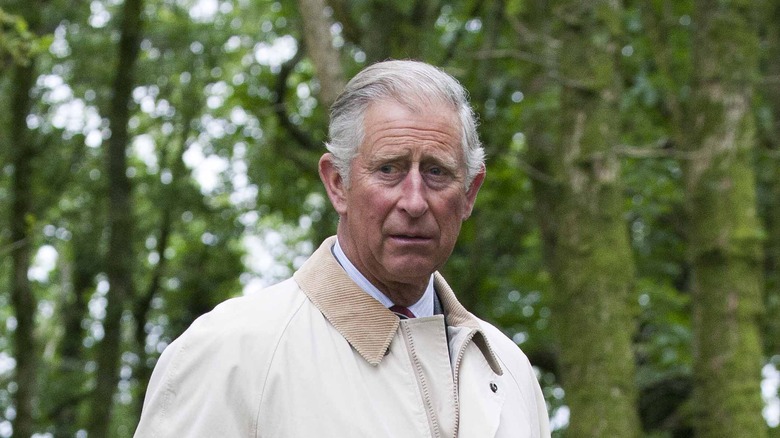Times King Charles Blatantly Broke Royal Protocol
The heir to the British throne has no prescribed constitutional role. While destined to be head of state, they're not officially required to do anything until they're crowned. They don't have to act on the government's advice and they don't have to run their speeches by ministers. But the heir to the throne, like other members of the royal family, will often be asked to support or represent the reigning sovereign at official events, where they will be expected to follow royal protocol. And if the heir has a constitutional requirement, it is to not upset or embarrass the institution they're set to inherit.
Not many would say that King Charles III perfectly observed that requirement in his 70 years as Prince of Wales. His divorce from Princess Diana, a first for British royalty, was a considerable embarrassment for the monarchy in the early 1990s. Other breaches of tradition and protocol on matters of dress, selfies, or seafood have been received more positively, or at least with good humor. But over the years, Charles has also been outspoken on a number of issues that touch on politics, an area where a constitutional monarch is required to practice neutrality.
While still Prince of Wales, he said that he wouldn't breach protocol in such ways as king. "Of course you operate within the ... the constitutional parameters," he told the BBC (via CNN). Nonetheless, some observers have grown nervous about what manner of monarch the outspoken Charles will become.
He was caught drinking in a pub at age 14
Teenagers are not often looked to as exemplars of intelligence, good judgment, and civic responsibility. And a young Prince Charles wasn't carrying out any royal duties when he found himself in Scotland at age 14. He was attending Gordonstoun School in Moray, where he was thoroughly unhappy and an average student. As Prince of Wales, he had protection: royal bodyguard Donald Green, whom Charles considered more of a friend than he did many of his schoolmates.
One night in June 1963, Charles and some of his peers sailed to the Isle of Lewis to see a movie. On their way, they stopped in at a pub, the Crown Hotel. Princes can fall into a "when in Rome" philosophy as easily as anybody; out for a night with the mates, Charles ordered a drink. According to Sally Bedell Smith's "Prince Charles: The Passions and Paradoxes of an Improbable Life," he blurted out the first drink he could think of, a cherry brandy, having had it before on a hunting trip.
This was perhaps less a breach of royal tradition than a violation of the law; 14-year-olds can't drink. A tabloid reporter at the Crown Hotel ran with the story, which became Charles's first unwelcome taste of the British press. Green was fired, to the prince's grief. But when Charles became king, the Crown Hotel invited him back for another drink. They even offered him another cherry brandy.
Charles broke royal birthing protocol more than once
Royal protocol extends even into such private areas as childbirth. To give birth at home was standard for most Britons, royal or commoner, until the 20th century. Queen Elizabeth II had all her children at either Buckingham Palace or Clarence House. Less common outside the monarchy was having a third party present to verify the birth and ensure there was no attempt to switch the royal babe with another.
Britain's variation on having a witness supervise the birth of a royal can be traced to at least 1688, when the doctor was late to the birth of Prince James and refused to sign off on the baby's regal nature. According to History, rumors surrounding James's true identity helped to fuel the Glorious Revolution. It was then required that the prime minister or home secretary attend royal births, a tradition broken with the birth of Prince Charles in 1948. King George VI insisted it wasn't needed.
Charles broke royal protocol in regard to the birthing bed again in 1982, when Prince William was born. Except for Prince Albert, the norm was for kings and Princes of Wales to wait outside while their heirs came into the world. But Charles was present for William's birth, and for Prince Harry's two years later. And both boys were born in a hospital, not a royal residence.
His second marriage was complicated by his constitutional role
For many years, Charles III was most known for his tumultuous and unsuccessful marriage to Princess Diana. While infidelity was nothing new in royal circles, a public scandal ending in a divorce pushed for by Queen Elizabeth II herself was. And another unusual development for the royal family was Charles's decision to marry his former mistress, Camilla Parker Bowles, in 2005, when Bowles was herself a divorcée and her former husband was still alive.
The queen gave her blessing to her eldest son's remarriage, but it faced a potential hurdle related to the monarchy's relationship with the Church of England. The reigning sovereign is also the supreme governor of the church. As he was still Prince of Wales at the time, this wouldn't immediately affect Charles, but he would one day come into that governorship along with the crown. At the time of his second wedding, the Church of England opposed divorced partners with living spouses getting remarried, though individual priests had discretion in the matter.
The solution wasn't a willing priest, but opting out of a religious service altogether. Charles and Bowles married in a civil service done in low-key (by royal standards) fashion. The queen's absence sparked rumors of a snub or a sign of disapproval, but spokesmen told the BBC that she was giving the reception and had agreed with Charles to keep away from the service to minimize press attention.
He signed a royal autograph
It's the coveted prize of many a celebrity chaser: the autograph. The signatures of movie stars, rock and roll guitarists, and top athletes are eagerly sought and highly valued. Given the fame of the British royal family, one might imagine that they sign plenty of autographs for fans and admirers. But royalty isn't the same as celebrity.
Protocol warns members of the royal family against giving out autographs, as it's said to be a precaution against forgery. The sovereign, as head of state, is part of the process of bringing legislation into force, not the sort of role that can afford to have fake signatures floating around. For other members of the family not in the direct line of succession, it's still seen as advisable not to take the risk that someone would put their name to shady use. Charles III's standard response when asked for an autograph, according to My London, is, "Sorry, they don't allow me to do that."
But he allowed himself, just once, after flooding devastated Cornwall in 2010. Charles, then Prince of Wales and Duke of Cornwall, visited an affected area and spoke with victims of the flood. The Daily Mail reported that one resident, Meg Hendy, dared to ask for an autograph for her son. Charles, to his security's surprise, agreed, though he cautioned that it wouldn't be the neatest signature he ever wrote; he almost never writes while standing up.
As prince, Charles was accused of planting staff in the civil service
Accusations that Charles III was a political meddler as Prince of Wales were often inspired by his own words. In speeches and writing, Charles volunteered opinions on architecture, the environment, and health care. There's no formal prohibition on the Prince of Wales giving such opinions in public, and there's no obligation for anyone in government to take them seriously. But there have been times when Charles's actions, or those of his staff, constituted a more serious breach of the protocol separating the monarchy from politics.
In 2013, The Sunday Times reported that members of Charles's staff had been seconded to government departments, for years at a time in some cases. Secondments are routine in British government, and staff are often seconded to the palace to advise members of the royal family ahead of state functions and foreign tours. But for the palace to send staff to government departments was unheard of. And while most secondments are transparent, neither the government nor Clarence House provided basic details on who had been seconded and why. Even some working ministers were kept in the dark.
The discovery of the secondments prompted angry questions in the House of Commons. Besides being seen as undemocratic, the secondments raised concerns about Charles's influence in government. One of his staff worked in Defra, the environmental department responsible for many of the issues Charles was publicly vocal about.
The black spider memos demonstrated political lobbying
Throughout the 2010s, The Guardian fought to obtain what it dubbed the black spider memos, 27 messages sent by Charles III between 2004 and 2005 — while he was still only heir to the throne — to government ministers on a variety of topics. The name was derived from the quality of Charles's handwriting.
The British government opposed the release of the memos, arguing that it could undermine monarchical neutrality, but the U.K. supreme court approved their being made public in 2015. The memos showed that Charles had been very frank with ministers, including then-Prime Minister Tony Blair, on matters ranging from safeguarding the Patagonian toothfish to the quality of equipment being given to British soldiers in the Iraq War. In at least one instance, according to The Guardian, Charles's lobbying was influential in delaying regulations on herbal medicine.
Many contributors to The Guardian, and some members of government, saw the memos as a sign of Charles having undue influence and pushed, at minimum, for more transparency in his communications with government. But outside of The Guardian, the British press and public's reaction was muted; Charles's memos covered matters he discussed publicly, had little direct impact, and paled compared to more aggressive lobbying efforts from moneyed interests with more selfish intentions. And constitutional scholars noted that past heirs to the throne were criticized for not being involved in state affairs.
He lobbied behind the scenes to overturn an architectural project choice
One of Charles III's most heated controversies over the years hasn't been over his marriage or his possible influence in politics, but his opinions on architecture. He's well-known in Britain for championing traditional styles and local materials, and for his vehement opposition to modernism. Ever since he referred to a proposed extension to the National Gallery as "a carbuncle on the face of a much-loved and elegant friend" (via The Guardian), he and a subset of architects and critics have been at loggerheads.
Royal protocol doesn't govern matters of taste, but it does urge kings and princes against getting involved in the minutia of city planning. One of Charles's most prominent interventions in British architecture came in 2009, when an architectural firm controlled by the Qatari royal family planned to build a housing project on the site of the former Chelsea Barracks. The design initially chosen was by Richard Rogers, an architect who embraced many of the stylistic ideas Charles opposes.
Rogers' design went through a regular planning process that, while not without its critics, was standard. Charles responded by writing to the prime minister of Qatar, urging that the royal family scuttle the design. He admitted (via the Evening Standard) that he was possibly in breach of protocol, but he felt strongly enough about the design to speak out. To Rogers' great annoyance, Charles got his way; the design was changed.
He walked Meghan Markle down the aisle
If not exactly a matter of constitutional protocol, it is traditional in royal as well as commoner weddings for a father to walk his daughter down the aisle. Prince Harry's marriage to Meghan Markle broke with tradition in several ways, from not having a kiss on the balcony of Buckingham Palace to the music played during the service. But it was expected until almost the last minute that Markle's father, Thomas, would be in attendance and give the bride away.
Unfortunately, the Markles experienced a public falling out in the week before the wedding. It was revealed that Thomas Markle and his daughter Samantha, Meghan's half-sister, had cooperated with paparazzi to stage photographs. Friends of Meghan's told People that, after the news broke, Thomas refused to answer her messages. She wasn't even told that her father had suffered a heart attack; she learned about it through the press. The attack kept Thomas from attending the wedding at all, let alone walking Meghan down the aisle.
Harry's father, still Prince Charles at the time, was asked to do the honors instead. While not customary, it wasn't without precedent. Prince Philip walked Princess Margaret down the aisle in 1960, and Queen Victoria stood in for her late husband Albert when her daughters were married.
He relaxed the dress code while meeting a noted artist
British royalty has peculiar and sometimes strict rules of dress. Color, cut, and style all have traditions and expectations behind them. If protocol around clothes is often more demanding on the women in the family, men aren't exempt. Charles III is rarely seen without a full suit, and British tabloids have had fun over the years with rumors about his particular habits, demands, and expectations concerning his wardrobe.
Dress codes extend beyond the walls of Buckingham Palace, of course. Even as dress becomes more casual throughout society, there are still times and places where it's expected that people will adopt formal wear. One such place is a luncheon held by the sovereign to honor recipients of the Order of Merit. Charles hosted his first such function in November 2022, and one of the recipients of the honor was artist David Hockney. The 85-year-old stood out from other attendees just by the style of his suit, a checked pattern instead of the more standard formal black. But it was his footwear that made headlines.
Hockney attended the luncheon wearing bright yellow crocs. According to The Guardian, not only were Charles's royal sensibilities not offended, he was delighted by the shoes. He did mistakenly refer to them as galoshes, but he did compliment Hockney on his outfit.
He, and his sons, are outspoken on climate change
Unlike the United States, climate change denial is rarely promoted in mainstream British politics, at least not publicly. While differences over preferred remedies and mitigations are continuously hashed out between opposing parties, the U.K. government has still managed to lower greenhouse gas emissions. In such a political climate, for a royal like Charles III to broadly advocate for environmentalism wouldn't seem to violate monarchical neutrality.
But Charles, and both of his sons, have gone further in advocating for specific policy aims. The king, while still the Prince of Wales, wrote a lengthy piece for Newsweek outlining strategies to speed up the transition to clean energy prescribed by his own Sustainable Markets Initiative, and he implied the need for a price on carbon. In the same essay, he highlighted Prince William's work to promote developing technologies and Prince Harry's commitment to the goal of reaching net zero emissions.
It has been the stated goal of U.K. governments since 2019 to achieve net zero — cutting greenhouse gas emissions and offsetting the remainder through carbon capture — by 2050 (per the UK Parliament). But Charles's advocacy for the goal has been criticized as a constitutional breach, in the U.K. and elsewhere in the Commonwealth realms.
